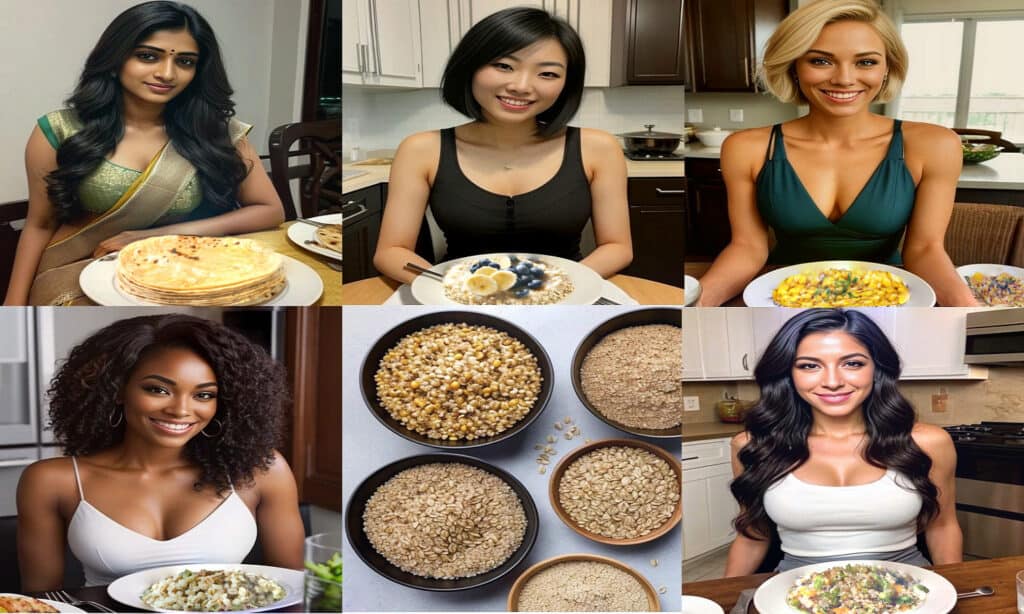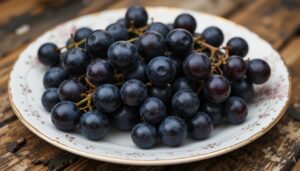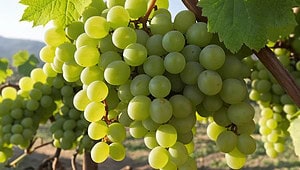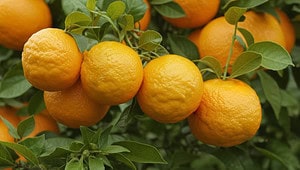Table of Contents
Whole Grains vs. Rice
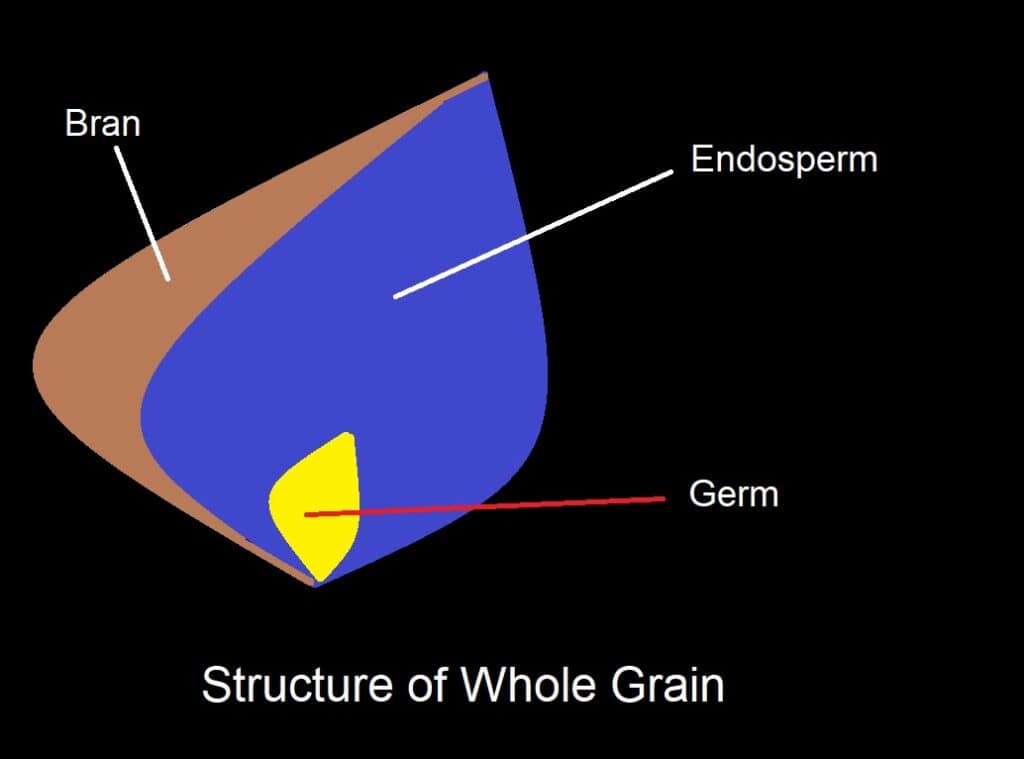
Rice is being eaten in Asia, some parts of Africa, and South America as the staple food. Rice is also consumed in many parts of North America and Europe. Among various rice varieties, White Rice is the preferred choice among people. However, various varieties of colored rice are also gaining popularity as they have more nutritious values than white rice.
White rice is a type of rice that mainly contains the endosperm of the rice grain. The endosperm is the section of the seed that is mostly carbohydrate. We do need carbohydrates, but a diet plan only containing carbohydrates may cause various lifestyle diseases. On the other hand, colored rice contains bran, endosperm, and germ. Bran is the section that has most of the fiber and germ contains essential minerals, antioxidants, and vitamins. In short, white rice is refined grain while various types of colored rice are whole grain. Replacing white rice with various types of colored rice is an essential wellness habit for a healthy life.
However, some alternatives are even better options than colored rice – whole grains. Whole grains are cereals that have bran, endosperm, and germ intact. In the case of refined grains – such as white rice – the outer inedible husk, edible bran, and germ are removed. White rice has only endosperm which contains mostly carbohydrates. Technically, various varieties of colored rice are also ‘whole grains’. However, all varieties of rice, including whole grain colored rice, have higher carbohydrate contents and high glycemic index. Compared to that, other whole grains have less carbohydrates and more nutrition, minerals, vitamins, and fiber. Whole grains also have a low glycemic index.
In this article, we are going to discuss about 5 such whole grains that are better staple food than rice.
1. Whole Wheat
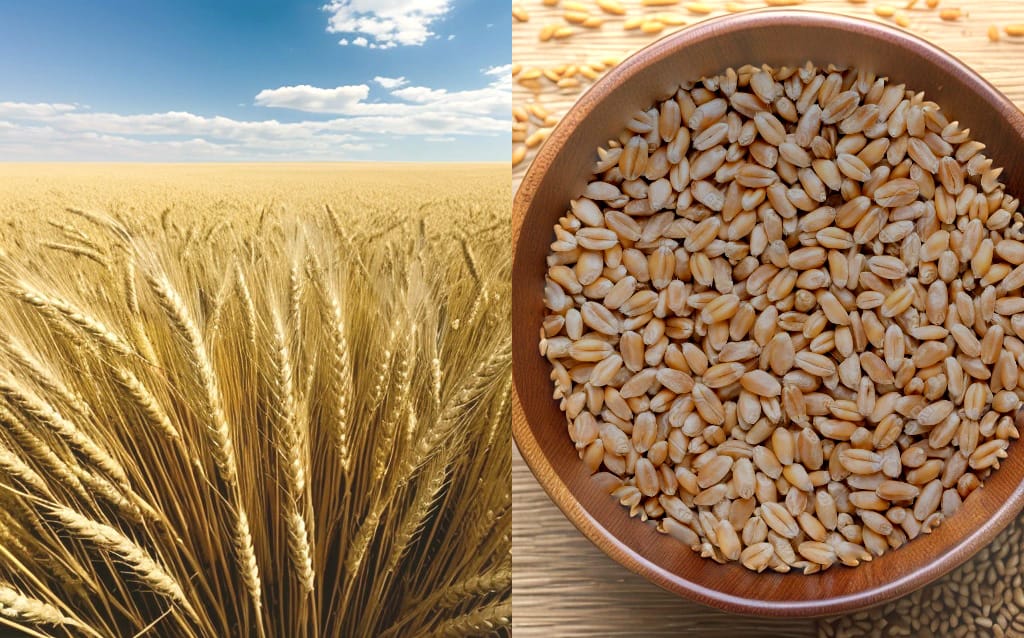
Wheat is a type of cereal that is cultivated throughout the World and is a staple food in North America, Europe, and some parts of Africa. Wheat is also consumed in large quantities in Asia and South America. Wheat plant is a type of grass (Poaceae family) and ‘Wheat’ is its seed. It has many varieties. Of all these varieties, common wheat, also known as Triticum Aestivum, is the most cultivated one.
A wheat whole grain contains an outer layer of bran, endosperm, and germ. The outer bran of whole wheat contains a large amount of fiber, some minerals, and a trace amount of vitamins. Endosperm is the potion that contains most of the carbohydrates. The germ of the wheat whole grain is portion form which sprouting could happen.
Unlike rice grain, wheat grain is not consumed as it is. Instead, the whole wheat grain is crushed and then it is transformed into fine flour. Through various cooking processes, the flour is made into various food itineraries which vary according to regions and countries. A wheat flour made out of wheat whole grain contains all the essential nutrients of bran, endosperm, and germ. However, refined wheat flour keeps out the bran and germ portion and only contains starchy endosperm. Hence, food items made out of refined flour are less healthy than those prepared from wheat whole grain.
Wheat whole grain flour is also a better choice than the rice. 100 grams of uncooked and raw rice grains have 360-380 calories while the same amount of wheat whole grain flour contains 330-340 calories. Whole wheat grain contains less carbohydrate compared to rice grains. Whole wheat is also a rich source of dietary fiber and protein. Whole wheat has almost triple dietary fiber compared to any type of rice – white or colored. Whole wheat also has double the amount of protein compared to rice.
Whole grain wheat also contains minerals such as iron, magnesium, calcium, selenium, copper, phosphorus, etc. It also has various essential vitamins such as vitamins B1, B3, B6, B9, B12, vitamin K, etc. Whole wheat, especially the bran and germ of the whole wheat, contains some essential phytochemicals and antioxidants such as Lutein, Phenolic acid, flavonoid, zeaxanthin, etc. Replacing rice with wheat whole grain will have some amazing health benefits. It helps build the immune system, regulate our blood sugar levels, build our muscles and bones, manage weight, provide relief from constipation, increase heart health, lower cholesterol levels, decrease the chances of cancer, etc.
It is important to remember that whole grain wheat contains a protein called gluten which can be found naturally in some whole grain cereals. Some people are sensitive to gluten and it may react negatively to their digestive system. It may also induce allergic reactions in these people. The gluten can also cause an autoimmune disease called celiac disease.
2. Whole Oat
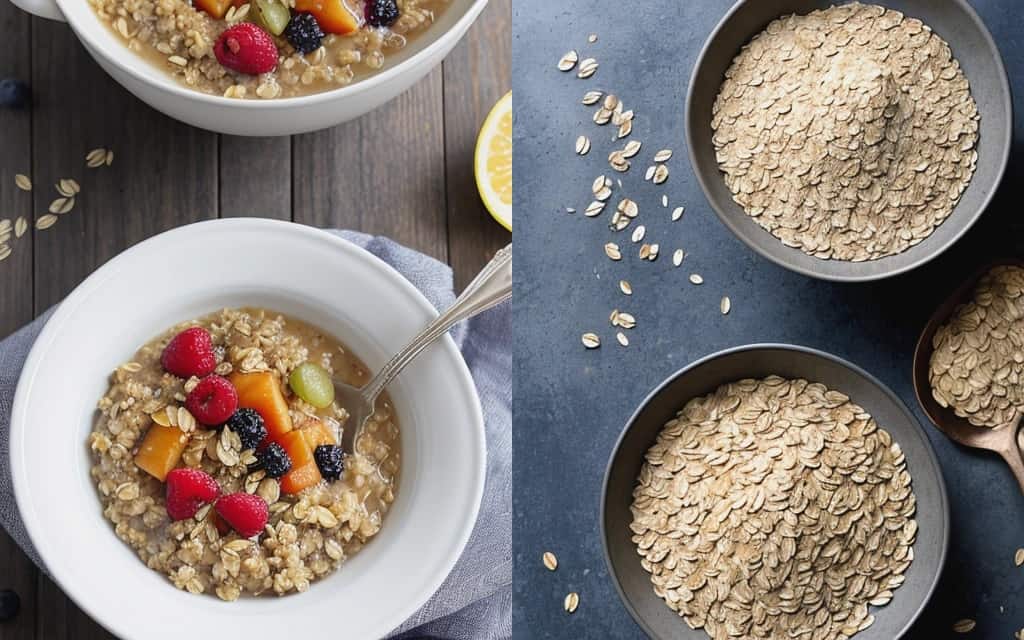
Oat, scientifically called ‘Avena Sativa’ is a type of cereal or seed that belongs to the Poaceae grass family. Oat is cultivated for human consumption but oats with outer husk can also be used for livestock feed. For human consumption, it is necessary to remove the inedible outer husk. After that, the whole grain oat, which includes edible bran, endosperm, and germ, may go through various processes before it can be ready for human consumption. Most processes change the Oats to some extent but the whole grain features of whole oats remain intact. Only the instant oats come with added sugar and other ingredients that make the already-cooked oats tasty.
Oat groats are the least processed of all the whole grain oats. Only the outer inedible husk of the Oat groats are removed. Oat groats can take longer time to cook and, they may have a hardy texture to them. The oat groats are sliced using steel blades to make little bits of the cereal. These are called Steel-cut oats or Irish Oats. They take less time to cook and have a smoother texture. Once the oat groats are crushed and milled and look somewhat like fine powder, they are called Scottish oats. Cooking these oats takes less time and they create a smooth and creamy pottage of oats.
The most common types of oats are rolled oats. To make these oats, oat groats are steamed. Then they are rolled and pressed down. Since they are rolled down, they are named rolled oats. As they are somewhat processed, they take less time to cook and have a slimy and smooth texture. All these types of oats are whole grain oats and they preserve most of the nutritious content of the whole oats. However, some divergence is possible due to the transforming processes. If someone is extremely fussy about only having whole grain oats, then he or she should go for oat groats which is the purest form of whole grain oats.
The health benefits of consuming whole grain oats are abundant. Replacing rice with oats will improve overall health and immunity. Oats are rich in water-soluble fiber, protein, vitamins (E, B1, B3, B5, B6, B9) minerals (zinc, iron, manganese, magnesium, copper, calcium, potassium), and antioxidants. Oats are especially rich in antioxidants and some rare antioxidants, like Hydroxycinnamoyl anthranilates, can only be found in oats. Hydroxycinnamoyl anthranilates, aka avenanthramides, are a group of antioxidants that have anti-inflammatory properties balance blood pressure and increase blood flow in the blood vessels.
Regular consumption of whole grain oats may improve heart health as oats contain beta-glucan which is a water-soluble fiber. This water-soluble fiber reduces bad cholesterol in the blood circulation. Beta-glucan is also responsible for reducing the glucose levels in blood and it may help us in our fight against type-2 diabetes. Along with it, Oats have a very low glycemic index (53-57) compared to rice (60-70) hence the carbohydrate in oats takes longer to turn to glucose in the bloodstream. As oats have a high content of fiber, they also help us maintain our weight and reduce obesity. Also, oats whole grains are gluten-free hence those who can’t consume whole wheat can turn to oats.
3. Corn or Maize
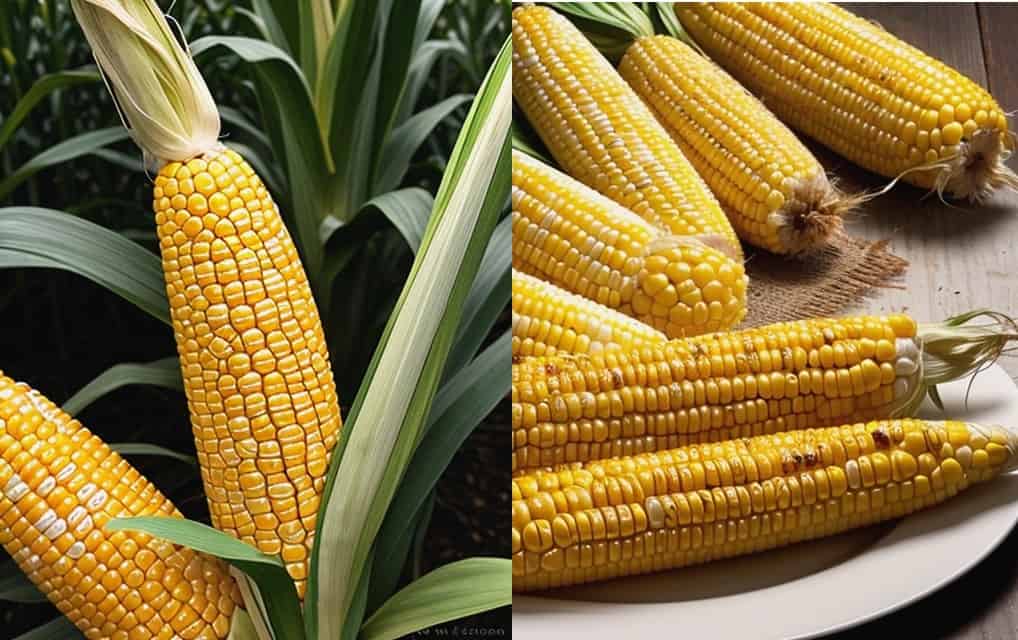
Corn, also known as Maize, is another edible grass seed cultivated worldwide. The corn seeds are arranged in a central pole-like structure called a cob. The cob, along with the corn seeds, is covered by a leafy outer husk. By weight, corn or maize is the most produced cereal in the world. The United States is the largest producer of corn.
Scientifically named, Zea Mays, it belongs to the grass family of Poaceae. The wild version of corn or maize is known as ‘teosinte’ and it is believed that native people in the Americas were cultivating the cereal almost 10,000-12,000 years ago. However, the teosinte was markedly different than the corn we know now. The domesticated version of corn first came into existence around 7,000-8,000 years ago in Mexico.
Corn is mainly grown for human consumption. The variety known as ‘sweet corn’, which has a genetic modification and a sweet taste to it, is grown mostly for human consumption. However, some varieties, such as ‘dent corn’, are also used as livestock feed. Corn is also cultivated to create biofuel Ethanol. Corn is mainly yellow. However, some varieties of corn can be multi-color and some can be various ranges of purple color. The corn whole grain comprises bran, endosperm, and germ.
As corn whole grain is naturally gluten-free, replacing rice with corn whole grain has immense benefits. Corn or maize is loaded with various healthy plant compounds that are absent in rice. The yellow corn whole grain gets its yellow hue from two antioxidants – lutein and zeaxanthin. These antioxidants are carotenoids that boost our overall eye health. They also help prevent various eye infections and increase the strength of our vision. The multi-color corn, called ‘Flint Corn’, and other corn varieties with a range of purple hues get their coloration due to the antioxidant – anthocyanin. Anthocyanin boosts our mental health and helps prevent inflammation, heart attacks, dementia, etc.
Apart from these three antioxidants, corn whole grain also has some other antioxidants such as quercetin, ferulic acid, p-coumaric, syringic, etc. In fact, of all the whole grains, corn has the highest amount of antioxidants. These antioxidants help increase our overall immunity. Quercetin has anti-inflammatory properties and helps us fight against cancer, heart disease, and inflammation of the prostate. It may also help us with Alzheimer’s disease.
Corn whole grain is rich in carbohydrates, water-soluble fiber, and protein. It also has loads of vitamins including vitamins C, B3, B5, B6, B9, etc. Corn also has various critical minerals such as copper, zinc, manganese, magnesium, potassium, phosphorus, etc. Corn also has a low glycemic index compared to rice, hence, it delays the absorption of glucose into the bloodstream, lowering the overall sugar level in the blood. Water soluble fiber in oats’ whole grains helps with the digestive system – preventing bloating, indigestion, constipation, etc. It also helps in reducing our weight.
4. Whole Barley
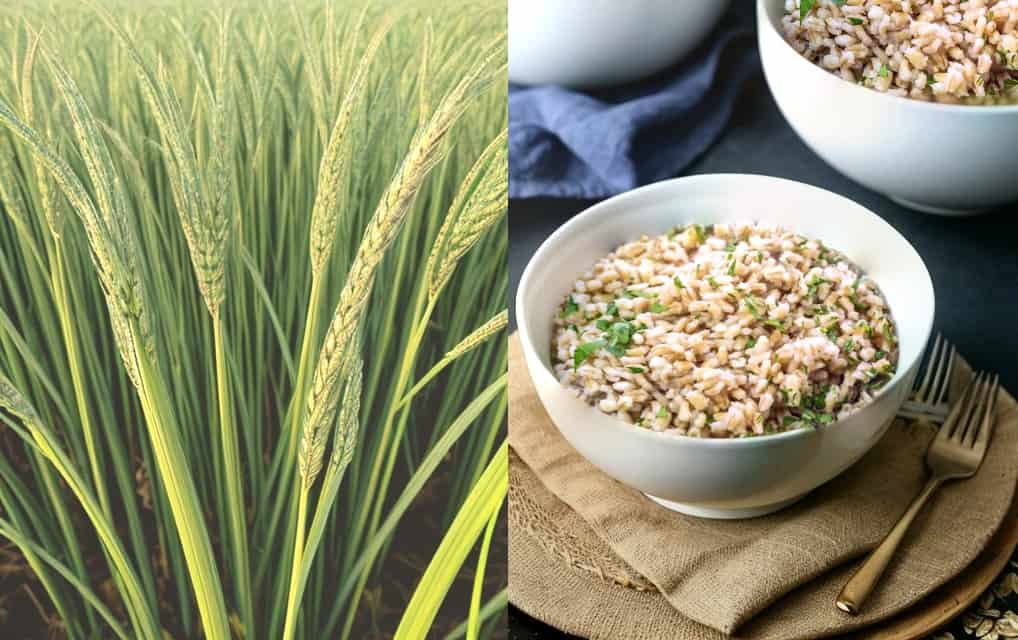
Barley, scientifically known as Hordeum Vulgare, is an edible cereal that belongs to the grass family of ‘Poaceae’. Along with corn or maize, it is one of the most ancient of the grains that humans have cultivated and domesticated. Ancient findings and records show that humans from the Mesopotamia region domesticated the barley around 10,000 years ago from wild barley called ‘Spontaneous Barley’ or ‘Hordeum Spontaneum’.
In terms of total production, currently, barley comes fourth after corn, rice, and wheat. European Union is the largest barley-producing region in the world. In terms of a single country, Russia is the largest barley producer. Apart from human consumption, barley whole grains are used as animal feed. Generally, six-row barley, which is high in protein content, is used as animal feed. Six-row barley is a type of whole grain barley that has six rows of kernels. Two-row barley, which has two rows of kernels and a higher sugar content, is used to make various alcoholic and non-alcoholic beverages.
Barley whole grains contain outer husk/hull, bran, endosperm, and germ. The outer hull or husk of barley’s whole grain is inedible and can be very tough to remove. In some versions of barley, such as ‘naked barley’, hull or husk can be removed with relative ease. For human consumption, the tough outer husk or hull has to be removed, leaving bran, endosperm, and germ. If the bran layer is also removed, then the grain will lose a significant amount of fiber and nutrition. Bran-less barley is called ‘pearl barley’. For health purposes, whole grain barley is preferred over pearl barley although pearl barley is easier to prepare.
Barley whole grain is a rich source of soluble fiber, protein, vitamins, minerals, and antioxidants. Compared to rice, whole grain barley has fewer carbohydrates, fewer calories, more protein, and much more dietary fiber. 100 grams of uncooked raw white rice has 80 grams of carbohydrates and 360-370 calories while 100 grams of hulled whole grain barley has 70 grams of carbohydrates and 340-350 calories. While the rice has 7-8 grams of protein, barley has one and a half times more protein. In terms of dietary fiber, barley outshines all other whole grains in the list with 18 grams of dietary fiber per 100 grams hulled whole grain barley.
The high fiber content in barley helps reduce weight and excess fat in the body. Besides high fiber content, a low glycemic index in barley helps control blood sugar levels. The high fiber content of barley also helps with indigestion and constipation. Beta-glucan, a type of water-soluble fiber present in whole grain barley helps reduce bad cholesterol in the bloodstream and increase the good cholesterol. It also reduces the overall cholesterol presence in the blood flow, improving heart health and reducing the chances of a heart attack.
Barley also has loads of antioxidants such as phenolic acids, lignans, saponins, etc, which help prevent various types of cancers. Barley is also rich in various vitamins such as Vitamin E, B1, B3, B6, B12, K, etc. Whole grain barley has loads of essential minerals such as manganese, magnesium, copper, phosphorus, selenium, etc. However, like wheat, barley does contain natural gluten. So those who have gluten intolerance must avoid barley.
5. Quinoa

Quinoa, scientifically named Chenopodium Quinoa, is a flowering annual plant and is cultivated for its edible seeds. It belongs to the subfamily of Chenopodioideae plant and the family of Amaranthaceae plants. Although, Quinoa is considered ‘whole grains’, technically its grains are not grains or cereals, rather they are classified as ‘Pseudograins‘ or ‘Pseudocereal’. In this article, all the above whole grains are real grains or cereals as they are seeds of grass (Poaceae). However, pseudograins plants, such as Quinoa plants, do not belong to the grass family. Rather these plants are broadleaf flowering plants whose seeds happen to be edible. Hence seeds of Pseudocereal plants are treated and consumed as whole grains.
Quinoa originated in South America and, 5,000-7,000 years ago, it was used as an animal feed. Then around 3,000-4,000 years ago, humans started to consume it as grains. In current times, it is widely cultivated in South American countries. Peru and Bolivia are the top 2 Quinoa producing countries and they account for almost 90% production of the Pesudocereal. The United States is the largest importer of Quinoa, accounting for 50% of the total Quinoa import. Since scientific research has confirmed the health benefits of Quinoa, its popularity and production have increased.
Quinoa seeds or whole grains come in various colors – yellow, whitish yellow, black, and red. The seeds have an outer hard hull or coat. Inside the hull, there are thin endosperm, embryo, and prominent perisperm. The grains’ hull or coat contains a natural pesticide called ‘Saponins’ which protects the seed from animals and bugs. It is bitter-tasting and not digestible. Before we could consume Quinoa, the Saponins have to be removed. While the endosperm and embryo have some starch and lots of protein and essential fats, the perisperm is mostly carbohydrate.
Compared to rice, quinoa whole grains provide some major health benefits. While rice has higher calories and a glycemic index of 72, Quinoa has lower calories and a glycemic index of 53. Quinoa also has more dietary fibers than the rice. In terms of protein content, Quinoa is even higher than whole grain wheat and whole grain barley. 100 grams of raw uncooked Quinoa contains up to 18 grams of protein. While dietary fiber helps us manage our weight, protein builds our muscle mass. Dietary fiber also helps with bowel movement and constipation. The lower calorie and glycemic index of Quinoa, coupled with its high fiber content, helps manage blood sugar levels.
Quinoa contains various Vitamins including Vitamin E, B1, B2, B6, B9, etc. It also has loads of essential minerals such as iron, zinc, copper, calcium, manganese, magnesium, phosphorus, potassium, etc. Quinoa is also a rich source of various polyunsaturated fatty acids (PUFAs) such as omega-3, and omega-6. Quinoa is also a rich source of antioxidants. It contains antioxidants such as Kaempferol and Quercetin. These antioxidants boost overall immunity and rid the body of free radicals. Including Quinoa in our daily diet may protect us from heart disease, various types of cancers, type-2 diabetes, inflammation, etc. It is also naturally gluten-free hence, gluten intolerant people can consume it without any consequences.
Caution

The whole grains mentioned in this article are good alternatives for rice. Replacing rice with these whole grains may provide a lot of health benefits. However, these whole grains do have their limitations. These cereals have to be consumed in measured quantities and have to be a part of a wholesome balanced diet. Excessive consumption of these whole grains may lead to health hazards such as indigestion, bloating, inflammation, vomiting, etc.
Some of the whole grains, such as whole wheat, and barley, may contain natural gluten which can cause some serious health issues. Gluten-intolerant people should avoid cereals that have natural gluten in them. Also, some gluten-free cereals may get contaminated with gluten through the manufacturing process. So, gluten-intolerant people may need to check that also. Also, some of these whole grains (wheat, oats, Quinoa, etc) do contain antinutrients (phytic acid, oxalates, etc) which prevent some of the minerals and nutrients from getting absorbed by our digestive systems.
Read More
- Indian Space Program: 8 Incredible Achievements
- China’s Space Program: 5 Amazing Accomplishments
- Top 6 Amazing Sources of Vitamin C (Fruits and Vegetables) That You Can’t Avoid
- Oranges: 11 Incredible Facts About This Tangy Citrus Fruit
- NASA’s MOXIE Creates O2: Big Step Towards Mars Colonization
- Lemons: 8 Astounding Facts About This Remarkable Super Fruit
- Top 5 Bitter Vegetables That Are Incredible For Our Health
- Grapefruit: 8 Incredible Facts About This Amazing and Tasty Superfruit
- Top 5 Amazing Properties of Time That Defy Common Sense
- Top 5 Important Citrus Fruits That You Should Know About
- 10 Factors for Emergence of Intelligent Life in The Universe
- Top 4 Important Vegetable Groups That You Should Be Aware Of
- Discoveries by JWST: 10 Incredible Findings of The Telescope
- Space Science: 6 Vital Reasons Why We Should Invest in It
- Solar System: 10 Astonishing Uniqueness of our star system
- Our Universe: An Incredible Journey of 13.7 Billion Years
- Indian Gooseberry (Amla): 10 Amazing Facts About This Wonder Fruit
- Top 6 Solar System Objects That Might Destroy Life On Earth
- The Great Physicist Peter Higgs Passes Away at 94
- Certain End of The Universe: 4 Forces of Nature to Watch Out For
- Big Bang: An Incredible Start of Universe 14 Billion Years Ago
*This article is only for informational purposes. Do not make your important decision based on this article only. In case of a medical emergency, please consult a medical professional or a doctor.

